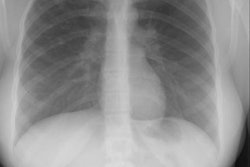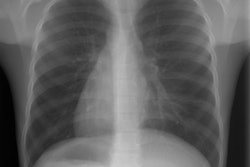Neuroendocrine Hyperplasia of Infancy
Clinical:
In neuroendocrine hyperplasia of infancy, neuroendocrine cells
are more numerous than normal cells throughout the airway
epithelium [1]. NEHI insidiously appears in the first year of life
and typically manifests with tachypnea, retractions, hypoxemia,
and failure to thrive [1,2].
X-ray:
The CXR may be normal or may reveal hyperinflation with variable
increased perihilar opacity [2].
HRCT appears to be the most reliable non-invasive imaging test
[2]. Multi-lobar ground-glass opacity predominantly involving the
right middle lobe and lingula, as well as a mosaic pattern of
air-trapping are typical findings on HRCT with a reported
sensitivity of 78-83 % and specificity of 100% [1,2]. However, the
diagnosis cannot be completely excluded with CT as up to 22% of
cases may not be identified [2].
REFERENCES:
(1) Radiographics 2017; Semple TR, et al. Interstitial lung
disease in children made easier...well, almost. 37: 1679-1703
(2) Ital J Pediatr 2016; Caimmi S, et al. Neuroendocrine cell
hyperplasia of infancy: an unusual cause of hypoxemia in children.
42: 84




